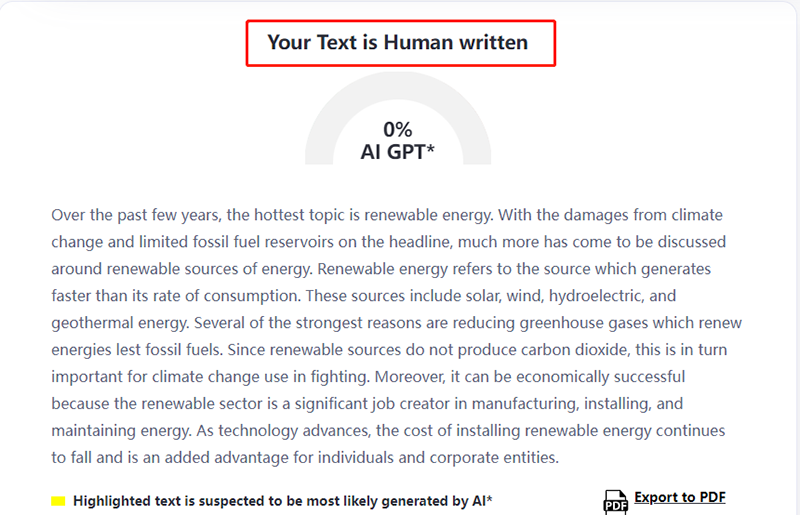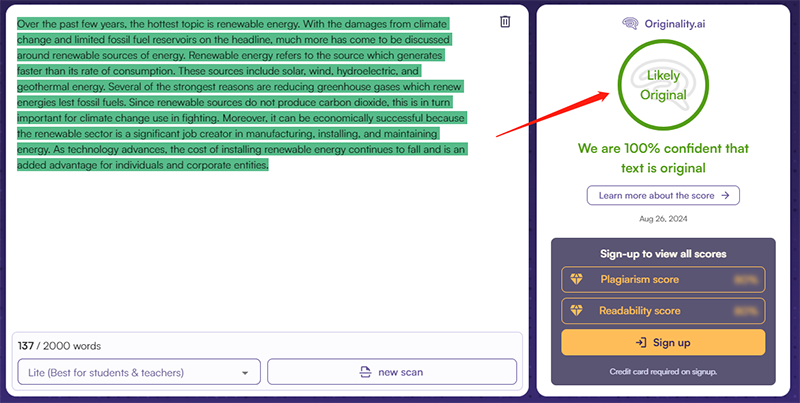Can Professors, Teachers, and Universities Detect ChatGPT?
With the rapid advancement of AI language models like ChatGPT, concerns about academic integrity have reached new heights. Can professors, teachers, and schools effectively detect AI-generated content?
In this post, we'll explore the methods professors use to identify ChatGPT-written assignments, the tools available to assist them, and strategies students might consider to bypass these detection measures.
Can Professors Detect Chat-GPT?
Yes, professors can detect ChatGPT with varying degrees of success. Detection is not solely based on the content itself but also on understanding each student's unique writing style and capabilities. Educators might also employ plagiarism checkers that have been updated to include databases of known AI-generated text patterns, although these are not foolproof.
Tips:
Fortunately, you can use the Tenorshare AI Bypass tool to avoid most robust AI detection systems. It is designed to convert AI to human text, while maintaining the original meaning.
How Do Professors Detect ChatGPT-Generated Content?
-
Plagiarism Checkers: While primarily designed to detect copied content, plagiarism checkers like Turnitin have been updated to identify AI-generated text.
-
AI Detection Tools: Specialized software can analyze text for patterns indicative of AI generation.
-
Questioning the Student: Professors may ask follow-up questions that require deeper understanding or critical thinking, which AI models often struggle with.
-
Analyzing Writing Style: They look for inconsistencies in writing style, such as sudden changes in tone, vocabulary, or complexity.
Best AI Detector for Teachers & Professors
Educators seeking to uphold academic integrity face new challenges with the rise of AI-generated content. Here are some of the most effective AI detectors designed to help teachers and professors identify AI-written work:
-
GPTZero: Specifically tailored to detect text generated by models like GPT-3, GPTZero analyzes writing for signs of AI authorship, focusing on the subtle nuances that differentiate human from machine writing.
-
Originality.AI: This tool combines plagiarism detection with AI content detection, offering a dual approach to ensure the originality of student submissions.
-
Winston AI Detector: Named for its robust detection capabilities, Winston helps educators quickly identify potentially AI-generated content, allowing for more precise scrutiny of student work.
-
Scribbr AI Detector: Part of the broader Scribbr academic services, this detector uses advanced algorithms to spot inconsistencies typical of AI-generated texts, supporting academic integrity efforts in educational institutions.
Also Read: 8 Best AI Content Detectors Reviewed
How Can I Bypass Professors' AI Detection?
Bypassing AI detection systems set by professors can be challenging, especially with the sophisticated AI tools available today.
However, we can still reduce the likelihood of detection through effective methods. The most recommended is to use a humanizing AI rewriting tool, as it is the quickest and simplest method.
Method 1: Manually Adjusting AI Text
Manually rewriting your AI-generated text by simply replacing words with their synonyms can be quite time-consuming and still poses a significant risk of being detected by AI systems.
Don't worry, there are more effective ways available to ensure your text remains undetected.
Method 2: Try Tenorshare AI Bypass Tool
Tenorshare AI Bypass is marketed as a solution for modifying AI-generated content to appear more "human-like". This tool adjusts the phrasing and structure of AI-generated text to make it less detectable by most AI detection tools.
Is Tenorshare AI Bypass Reliable?
Is it worth investing in Tenorshare AI Bypass?
Absolutely! Next, let's test its effectiveness at evading AI detection. We will use some of the strongest AI detectors on the market: GPTZero, ZeroGPT, and Originality.ai.
Testing the Effectiveness of Tenorshare AI Bypass
Using this rewriting tool is incredibly simple; it usually requires just one click to generate undetectable text. First, we generate a 100% AI text using ChatGPT-4, then paste it into the tool's input box, and click the "Humanize" button to receive high-quality rewritten text.

Tenorshare AI Bypass vs. GPTZero - Results: 2% AI, 98% human score. This AI bypasser successfully beats GPTZero's detection.

Tenorshare AI Bypass vs. ZeroGPT - Results: 0% AI, 100% human score.The Tenorshare's AI humanizer has won once again.

Tenorshare AI Bypass vs.Originality.ai - Results: 0% AI, 100% human score.The victory is clear.

The series of tests outlined above clearly demonstrate the prowess of Tenorshare AI Bypass in transforming AI-generated content into text indistinguishable from human writing.
Tenorshare AI Bypass proves itself as a highly effective tool for anyone looking to bypass AI detection systems. Whether for academic purposes, content creation, or ensuring privacy, this tool offers a reliable solution for producing text that retains the depth and nuance of human input while staying under the radar of AI detection technologies.
Tenorshare AI Bypass
- Create 100% undetectable human-like content.
- Bypass All Al detector tool like GPTZero, ZeroGPT, Copyleaks, etc.
- Original content, free of plagiarism and grammatical errors.
- One-Click AI bypass with a clean and easy-to-use interface
Final Thoughts
Can professors detect ChatGPT-generated content? Theoretically, yes. We are currently at a pivotal moment in the history of artificial intelligence. The use of AI tools for writing is inevitable as technology becomes increasingly integrated into our daily lives, including in educational settings.
As AI evolves, so do the methods for detecting its output. Professors and educational institutions are increasingly utilizing sophisticated AI detection tools that can analyze writing for patterns that typically signify machine generation.
In response to these advancements, AI to human converter tools like Tenorshare AI Bypass have been developed to help users adapt their AI-generated content to make it less detectable. This software modifies the text to mask AI characteristics, making it appear more human-like and helping it evade the sophisticated algorithms used by AI detectors in academic environments.
FAQs
How to make ChatGPT undetectable?
The quickest and simplest method is using tools like Tenorshare AI Bypass. This tool is designed to modify AI-generated text in a way that masks its machine-origin characteristics, making it appear more human-like and thus less likely to be flagged by detection software.
Can Turnitin detect ChatGPT?
Yes, Turnitin can potentially detect ChatGPT-generated content. Turnitin has been updating its algorithms to recognize patterns typical of AI-generated text, making it more capable of identifying submissions that do not exhibit the typical variances found in human-written work.
Can Canvas detect ChatGPT?
Canvas itself does not have built-in capabilities to detect AI-generated text like ChatGPT. However, Canvas integrates with plagiarism detection tools such as Turnitin, which can be used within the system to check for AI-generated content.
Can schools detect ChatGPT?
Schools can detect ChatGPT-generated content using AI detection software. Increasingly, educational institutions are employing tools designed to identify the specific linguistic patterns and consistency levels characteristic of machine-generated text.
Can teachers tell when you use ChatGPT?
Teachers may be able to tell when a student uses ChatGPT based on the content's style, tone, and depth. Sudden improvements in writing quality or shifts in writing style can be indicators, along with a lack of personal insight or unusual clarity on complex topics.
You Might Also Like
- Can Turnitin Detect Quillbot? Find Out the Answer Below!
- Can Canvas Detect ChatGPT? Use Tenorshare to Bypass
- How Accurate & Reliable are AI Detectors?
- AI Detector Score Meaning: How to Interpret and Bypass Detection
- How to Bypass GPTZero AI Detector: Effective Strategies for Undetectable AI Text
- How to Beat Turnitin AI Detection 2026 in 5 Ways
- Turnitin Plagiarism Checker Review: Features, Pros, Cons, Accuracy
- What Does Perplexity & Burstiness Mean in AI and Human Writing?

